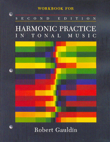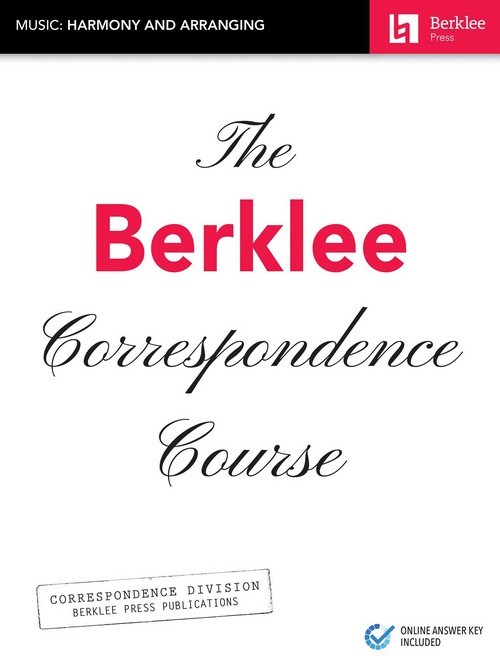
Harmonic Practice in Tonal Music
Gauldin, Robert
W. W. Norton & Company. 2004Ficha técnica
- EAN: 9780393152746
- ISBN: 978-0-393-15274-6
- Editorial: W. W. Norton & Company
- Fecha de edición: 2004
- Encuadernación: Cartoné
- Dimensiones: 24x20
- Idioma: Inglés
- Nº páginas: 895
No disponible temporalmente
Disponibilidad sujeta a la información del editorPVP. 44,20€
Añadir a la Lista de deseos
Second Edition.
Contains Hardback and CD-Audio (Audiobook).
Conceptually sophisticated and exceptionally musical, Harmonic Practice in Tonal Music provides a thorough treatment of harmony and voice-leading principles in tonal music. Taking a linear functional approach, Professor Gauldin uses clear explanations and outstanding musical examples to show students how individual chords function in the overall structure of a piece, explaining how both harmonic and melodic forces contribute to the development of musical ideas.
For the Second Edition, Professor Gauldin has undertaken a comprehensive revision that responds directly to the suggestions of instructors. The new text emphasizes fundamental concepts, using a more effective organization and simpler, more accessible language to bring the most important ideas and information to the foreground.
CONTENIDO:
(*) indicates a section that has been comprehensively rewritten or is entirely new to this edition
Part I: The Basic Elements of Music
Chapter 1 Pitch and Intervals
(*) Pitch Notation and the Diatonic Pitch Collection
(*) Pitch Register and Pitch Class
Half Steps and Accidentals
(*) The Natural or White-Key Intervals
(*) Simple and Compound Intervals
(*) Spelling Intervals with Accidentals
Interval Inversion
Consonant and Dissonant Intervals
Terms and Concepts for Review
(*) A Brief Review Self-Quiz
Chapter 2 Rhythm and Meter I: Beat, Meter, and Rhythmic Notation
(*) The Beat and Tempo
Metrical Grouping and Meter
(*) Division and Subdivision of the Beat
Rhythmic Notation
The Beat Value
Meter Signatures in Moderate Tempo
(*) Some Guidelines for Rhythmic Notation
Terms and Concepts for Review
(*) A Brief Review Self-Quiz
Chapter 3 Tonic, Scale, and Melody
Tonic and Tonality
The Major Mode and Major Scale
Diatonic Scale Degrees
The Minor Mode and Minor Scale
(*) The Transposition of Scales and Melodies
Relative and Parallel Keys
(*) The Circle of Fifths
Key Signatures
(*) The Function of Scale Degrees in Melody
Melodic Phrases
Melodic Cadences
(*) Two Melodic Analyses
Terms and Concepts for Review
(*) A Brief Review Self-Quiz
Chapter 4 Triads and Seventh Chords
Root-Position Major and Minor Triads
Inversions of Major and Minor Triads
Diminished and Augmented Triads
Triad Spelling and Notation
Figured Bass
Seventh Chords
(*) Inversions of Seventh Chords
Terms and Concepts for Review
(*) A Brief Review Self-Quiz
Chapter 5 Musical Texture and Chordal Spacing
Basic Categories of Texture
Strict vs. Free Texture
Four-Voice Texture
Chordal Spacing in Four-Voice Texture
Doubling in Four-Voice Chords
Voice Movement within the Same Triad
Chordal Implication in Two-Voice Texture
Terms and Concepts for Review
(*) A Brief Review Self-Quiz
Chapter 6 Partwriting in Four-Voice Texture
Criteria for Melodic Writing
Melodic Motion between Voices
Voice Leading
Partwriting
Principles of Melodic Writing
(*) Connecting Chords
Perfect Intervals in Succession
Chordal Spacing or Structure
Chordal Doubling
Terms and Concepts for Review
(*) A Brief Review Self-Quiz
Chapter 7 Melodic Figuration and Dissonance I: Categories of Embellishing Tones
(*) Essential and Embellishing Notes
Chordal Embellishment and Compound Melody
(*) Categories of Dissonant Embellishing Tones
Unaccented/Stepwise Embellishing Tones
Unaccented/Leaping Embellishing Tones
Accented/Stepwise Embellishing Tones
Accented/Leaping Embellishing Tones
Free Tones
(*) Consonant Embellishing tones
The Pedal Point
The Perception of Embellishing Tones
Terms and Concepts for Review
(*) A Brief Review Self-Quiz
Part II: Diatonic Harmony
Chapter 8 Introduction to Diatonic Harmony
Aspects of Harmony
Roman Numerals
Harmonic Tendency
(*) The Underlying Basis for Harmonic Tendency
The Influence of Melodic Sequences on Harmonic Tendency
Harmonic Models
Terms and Concepts for Review
(*) A Brief Review Self-Quiz
Chapter 9 The Primary Triads: Tonic, Dominant, and Subdominant Chords
Tonality as the Extension of Tonic Harmony
The Prolongation of Tonic Harmony
(*) The Tonic, Dominant, and Subdominant Triads
(*) Relationships between the Primary Chords
(*) Partwriting Connections between the Primary Triads
(*) The Polarity between Tonic and Dominant Chords
The Authentic Cadence
The Half Cadence
(*) The Plagal Cadence
Voice-Leading Reduction
(*) Cadential Expansion within the Phrase
Harmonizing Melodies
(*) Elaborating Harmonic Models
Terms and Concepts for Review
(*) A Brief Review Self-Quiz
Chapter 10 The Dominant Seventh: Embellishing the Tonic Harmony
The Dominant Seventh in Root Position
Preparation and Resolution of the V7
(*) The Cadential Dominant Seventh
(*) Arpeggiated Tonic Prolongation within the Phrase
(*) Prolongation of Tonic Harmony using Embellishing Chords
Melody Harmonization
(*) The Elaboration of a Harmonic Model
Terms and Concepts for Review
(*) A Brief Review Self-Quiz
Chapter 11 The Tonic and Subdominant Chords in First Inversion: The IV and I as Embellishing Chords
(*) Partwriting with the I6 and IV6
(*) The Use of the I6
(*) The Use of the IV6
(*) The IV as an Embellishing Chord
The I as an Embellishing Chord
Melody Harmonization
(*) Elaboration of Harmonic Models
Terms and Concepts for Review
(*) A Brief Review Self-Quiz
Chapter 12 Phrase Structure and Grouping
Phrase Length
(*) Larger Phrase Grouping: The Period Family
(*) Double Periods
(*) Some Miniature Formal Designs
Phrase Periodicity
Phrase Extension, Contraction, and Elision
Varied Phrase Lengths
The Internal Anatomy of Phrases: Sub-Phrases and Sentence Structure
(*) Motives and their Development
(*) Pitch and Rhythmic Motives
Terms and Concepts for Review
(*) A Brief Review Self-Quiz
Chapter 13 Linear Dominant Chords: V6, viio6, and Inversions of V7
(*) The V6, viio6, and Inversions of V7
(*) Uses of the V6 and viio6
(*) Embedded Voice-leading Motion
(*) Examples of the V6 and viio6 in Music Literature
(*) Inversions of the V7
(*) Examples of the Inverted V7 in Music Literature
Arpeggiated Extensions of Dominant Harmony
Exceptional Treatments of the Chordal 7th
(*) Extended Embellishment of the Tonic Harmony
Melody Harmonization
Terms and Concepts for Review
(*) A Brief Review Self-Quiz
Chapter 14 The Pre-Dominant II and II7 Chords
(*) The Supertonic Family
(*) Partwriting with Supertonic Chords
(*) The Pre-dominant ii6 and ii6/5 in Cadential Formulas
(*) Supertonic Harmony in Embellishing Progressions
Examples of Supertonic Harmony in Music Literature
Prolongation of the Pre-Dominant Function
Melody Harmonization
Terms and Concepts for Review
(*) A Brief Review Self-Quiz
Chapter 15 Melodic Figuration and Dissonance II: Suspensions and Other Uses of Embellishing Tones
Suspensions in Two-Voice Texture
Suspensions in Four-Voice Texture
Ornamental Resolutions
(*) Additional Suspension Techniques
Multiple Suspensions
Suspensions as a Compositional Device
Melody Harmonization
(*) Other Features of Embellishing Tones
(*) The Interaction of Consecutive or Simultaneous Embellishing Tones
(*) Some Analytical Problems with Embellishing Tones
The Affective Nature of Melodic Dissonance
Embellishing Tones in Partwriting and Melody Harmonization
Terms and Concepts for Review
(*) A Brief Review Self-Quiz
Chapter 16 Theand Other Linear Chords
The Accented or CadentialChord
(*) Elaborating the Cadential
(*) Exceptional Treatments of the Cadential
The PassingChord
The PedalChord
The ArpeggiatedChord
(*) Other Treatments of the Cadential
(*) The Extendedand the Cadenza
Melody Harmonization
Other Diatonic Linear Chords
Terms and Concepts for Review
(*) A Brief Review Self-Quiz
Chapter 17 The VI, III, and Other Diatonic Triads
(*) The Submediant and Mediant Triads in Major and Minor
The Root-position VI between Tonic and Pre-dominant Harmonies
The VI as a Substitute for I: the Deceptive Cadence and Progression
(*) Other Treatments of the V - vi Progression
The Root-position III Triad within the Phrase
(*) The ?First-inversion? VI and III as Voice-leading Substitutes for I and V
Modal Chords
Other Diatonic Triads: The v6 and VII in Minor
Melody Harmonization
Terms and Concepts for Review
(*) A Brief Review Self-Quiz
Chapter 18 Rhythm and Meter II: Additional Meter Signatures and Rhythmic-Metrical Dissonance
Meter Signatures in Very Slow or Fast Tempo
Asymmetrical Meters
(*) Fast Complex Meters
(*) Rhythmic-Metrical Consonance
(*) Rhythmic Dissonance
Metrical Dissonance
Terms and Concepts for Review
(*) A Brief Review Self-Quiz
Chapter 19 The Leading-Tone Seventh Chord and Other Seventh Chords
The Leading-Tone Diminished-Seventh Chord in the Minor Mode
(*) Partwriting with the viio7 in the Minor Mode
Other Uses of the viio7
The Leading-Tone Seventh Chord in the Major Mode
Melody Harmonization
(*) Other Diatonic Seventh Chords: the IV7, I7, VI7, and III7
Terms and Concepts for Review
(*) A Brief Review Self-Quiz
Chapter 20 Harmonic Sequences I: Triadic Root Movement by 5th, 2nd, and 3rd
Sequential and Nonsequential Root Movement
Harmonic Sequences
(*) Triadic Root Movement by Descending 5th
(*) Triads in Descending 5th Sequences
(*) Triads in Ascending 5th Sequences
Root Movement by 2nd: Successive First-inversion Chords
Sequences of Root-position Triads in Stepwise Motion
Root Movement by Descending and Ascending 3rd
Harmonic Sequences in Melody Harmonization
Terms and Concepts in Review
(*) A Brief Review Self-Quiz
Chapter 21 Tonicization and Modulation I: Secondary Dominant Chords
(*) Secondary or Applied Dominant Chords
Approaching Altered Notes in Secondary Dominants
Tonicization of the Dominant
Tonicization of the Subdominant
Tonicization of ii, vi, and iii in the Major Mode
Tonicization of III, VI, and VII in the Minor Mode
Cross Relations
Extended Successions of Secondary Dominants
Melody Harmonization
Terms and Concepts for Review
(*) A Brief Review Self-Quiz
Chapter 22 Tonicization and Modulation II: Motion to V and III
Modulation
Methods of Modulation
(*) Modulation to the Dominant Key in the Major Mode
Intermovement Tonal Schemes Involving Modulation to the Dominant
(*) Modulation to the Relative Major in the Minor Mode
Intramovement Tonal Schemes Involving Modulation to the Relative Major Key
Melody Harmonization
Terms and Concepts for Review
(*) A Brief Review Self-Quiz
Chapter 23 Harmonic Sequences II: Sequences of Seventh Chords and Other Sequences
Diatonic Root-position Seventh Chords in Sequences Descending by 5th
(*) Sequences using Inverted Diatonic Seventh Chords
(*) The Use of Secondary Dominants in Harmonic Sequences
Other Diatonic Sequences
(*) Sequences as a Means of Modulation
Unusual Treatment of Seventh Chords in Sequential Movement
The Elaboration of Sequences
Terms and Concepts in Review
(*) A Brief Review Self-Quiz
Chapter 24: Simple Forms
(*) Content and Form
(*) Formal Design and Tonal Structure
One-Part Form
Binary or Two-Reprise Design
The Two-Reprise Design in the Baroque Period
The Two-Reprise Design in the Classical Period
Ternary Form
Variation Form
Baroque Continuous Variations
Sectional Variations, or Theme and Variations
Rondo Form
The Five-Part Rondo
The Seven-Part Rondo
Terms and Concepts for Review
(*) A Brief Review Self-Quiz
Chapter 25 Analytical Comments on a Menuetto and Trio by Beethoven
Larger Formal Considerations
Formal Characteristics of Beethoven?s Menuetto and Trio
Motives and Phrase Grouping in the Menuetto
Voice Leading in the Menuetto
Motives and Phrase Groupings in the Trio
Middleground Voice Leading in the Trio
Overall Voice Leading in the Menuetto and Trio
Unifying Factors in the Movement
Terms and Concepts in Review
(*) A Brief Review Self-Quiz
Part III: Chromatic Harmony
Chapter 26 Introduction to Chromatic Harmony
The Historical Evolution of Non-Diatonic Tones
Chromatic Melodic Motion
(*) Enharmonic Duality
Decorative versus Structural Chromaticism
Using Roman Numerals to Designate Chromatic Harmonies
Terms and Concepts for Review
(*) A Brief Review Self-Quiz
Chapter 27 Tonicization and Modulation III: Modulations to Closely Related Keys
Closely Related Keys
Relative Frequency of Closely Related Keys
The Extent of the Tonicized Area
The Process of Modulating to Closely Related keys
Tonal Schemes Within a Movement
Melody Harmonization
Terms and Concepts for Review
(*) A Brief Review Self-Quiz
Chapter 28 Modal Exchange and Mixture Chords
Modal Exchange
Mixture Chords
Mixture Chords in the Major Mode
Mixture Chords in the Minor Mode
The III Triad as a Secondary Mixture Chord in Major
The Relationship between Scale Degrees #5 versus b6
Melody Harmonization
Terms and Concepts for Review
(*) A Brief Review Self-Quiz
Chapter 29 The Neapolitan or bII Chord
(*) A Question of Terminology: iv b6-5 vs. bII6
(*) The Neapolitan Sixth in Minor and Major Modes
(*) The bII6 as an Embellishing Chord
(*) Other Characteristics of the bII6
Other Uses of the Neapolitan Chord
Tonicization of the Neapolitan Harmony
Melody Harmonization
Terms and Concepts for Review
(*) A Brief Review Self-Quiz
Chapter 30 Augmented Sixth Chords
(*) The Three Common Forms of Augmented Sixth Chords
(*) The Italian, German, and French Augmented Sixth Chords in the Minor Mode
Augmented Sixth Chords in the Major Mode
Secondary Augmented Sixth Chords
Inversions of the Augmented Sixth Chords
Other Resolutions of Augmented Sixth Chords
Enharmonic Augmented Sixth Chords
More Exotic Augmented Sixth Chords
Melody Harmonization
Terms and Concepts for Review
(*) A Brief Review Self-Quiz
Chapter 31 More Extended Homophonic and Contrapuntal Formal Designs
Sonata Form
Sonata-Rondo Form
Concerto Form
Contrapuntal Forms
Terms and Concepts for Review
(*) A Brief Review Self-Quiz
Chapter 32 Embellishing Chromatic Chords
Augmented Triads as Passing or Neighboring Chords
Altered V7 Chords
Embellishing or Common-Tone Diminished-Seventh Chords
Common-Tone Augmented Sixth Chords
Unusual Linear Chords
Additional Chromatic Chords in the Major and Minor Modes
(*) The Use of Chromaticism to Create Modal Ambiguity
Melody Harmonization
Terms and Concepts for Review
(*) A Brief Review Self-Quiz
Chapter 33 Dominant Prolongation
Short-Term Chromatic Prolongation of V(7)
Prolongation of the Dominant in Introductions
Prolongation of the Dominant in Retransitions
Prolongation of the CadentialFormula
Dominant Prolongations as Preparation for a Climax
Terms and Concepts for Review
(*) A Brief Review Self-Quiz
Chapter 34 Modulations to Foreign Keys I
Modulations to Foreign Keys in the Major Mode
Change-of-Mode Modulation
Third-Related Modulations by Common Tone
Modulations to Foreign Keys by Pivot Chord
Modulations to Foreign Keys in the Minor Mode
Foreign Key Relations in Development Sections
Melody Harmonization
Terms and Concepts for Review
(*) A Brief Review Self-Quiz
Chapter 35 Ninth, Eleventh, Thirteenth, and Added-Note Chords
(*) General Considerations
Dominant Ninth Chords
Non-dominant Ninth Chords
Eleventh and Thirteenth Chords
Added Notes: 6ths and 9ths
Terms and Concepts for Review
(*) A Brief Review Self-Quiz
Chapter 36 Implication and Realization
Music as Communication
Referentialism versus Absolutism
The Origins of Emotion in Music
Implication and Realization
Surprise and Ambiguity
Application to Musical Analysis
Terms and Concepts for Review
(*) A Brief Review Self-Quiz
Chapter 37 Harmonic Sequences III: Chromatic Elaborations of Diatonic Sequences
(*) Fifth-Related Chromatic Sequences
The Role of Diatonic Tetrachords in Stepwise Chromatic Sequences
Chromatic Elaborations of Diatonic Stepwise Sequences
Extended Use of Chromatic 5-6 Sequences
Terms and Concepts for Review
(*) A Brief Review Self-Quiz
Chapter 38 Analytical Comments on Wagner?s Tristan Prelude
Part IV: Advanced Chromatic Techniques
Chapter 39 Chromatic Voice Leading
Sequences Based on Half-Step Movement
Strict Chromatic Parallelism
Chromaticism by Contrary Motion
Nonsequential Chromatic Passages
Extended Use of Nonsequential Chromaticism
Terms and Concepts for Review
(*) A Brief Review Self-Quiz
Chapter 40 Modulations to Foreign Keys II
Enharmonic Modulation
Chromatic Alterations of Diminished Seventh Chords
Modulation by Strict Harmonic Sequence
Modulation by Chromatic Linear Progression
Terms and Concepts for Review
(*) A Brief Review Self-Quiz
Chapter 41 Symmetrical Divisions of the Octave
Symmetrical Root Movements (by Major 2nd, Minor 3rd, Major 3rd, and Tritone)
Extended Root Movement by Perfect 5th
The Omnibus Sequence
Tonal Schemes Using Symmetrical Divisions of the Octave
Terms and Concepts for Review
(*) A Brief Review Self-Quiz
Chapter 42 At the Limits of Tonality: Alban Berg?s Four Songs, Op. 2
Terms and Concepts for Review
Appendix 1 Some Fundamentals of Acoustics
Frequency and Pitch
Intensity and Loudness
Vibration Form and Timbre
Duration and Length
Appendix 2 The Diatonic Church Modes and Other Scales
The Eccliastical or Church Modes
Other Scales
Appendix 3 An Introduction to Species Counterpoint
Melodic Characteristics
First Species
Second Species
Third Species
Fourth Species
Fifth Species
Underlying Species Technique in Two-Voice Passages
Appendix 4 Chord Symbols for Jazz and Commercial Music
Triads
Seventh Chords
(*) Extended Tertian Chords
Appendix 5 Conducting Patterns
Duple Meter
Triple Meter
Quadruple Meter
Single Meter
Quintuple Meter
Sextuple Meter: Divided Beat
Complex Meters
Appendix 6 Transposing Instruments
(*) Concert Instruments
(*) Transposing Instruments
(*) Classical Brass Transpositions, Crooks, and Transpositions
Answers to the Self-Review Questions
Glossary






